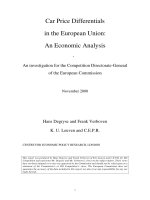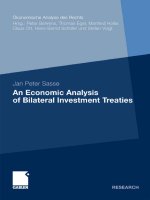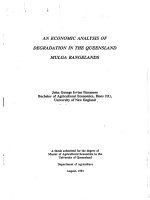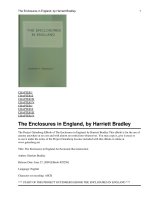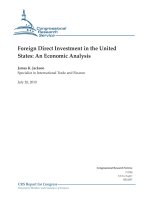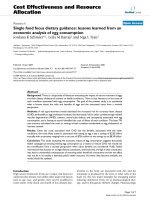deangelo - 1982 - the auditor-client contractual relationship - an economic analysis
Bạn đang xem bản rút gọn của tài liệu. Xem và tải ngay bản đầy đủ của tài liệu tại đây (414.56 KB, 3 trang )
The Auditor-Client Contractual Relationship: An Economic Analysis by Linda Elizabeth
DeAngelo
Review by: Wanda A. Wallace
The Accounting Review,
Vol. 57, No. 3 (Jul., 1982), pp. 643-644
Published by: American Accounting Association
Stable URL: .
Accessed: 08/05/2014 19:02
Your use of the JSTOR archive indicates your acceptance of the Terms & Conditions of Use, available at .
/> .
JSTOR is a not-for-profit service that helps scholars, researchers, and students discover, use, and build upon a wide range of
content in a trusted digital archive. We use information technology and tools to increase productivity and facilitate new forms
of scholarship. For more information about JSTOR, please contact
.
American Accounting Association is collaborating with JSTOR to digitize, preserve and extend access to The
Accounting Review.
This content downloaded from 169.229.32.137 on Thu, 8 May 2014 19:02:28 PM
All use subject to JSTOR Terms and Conditions
Book
Reviews
643
Inflation
Will Ration
The Goods of
The Nation
As the title
suggests,
this
book
is
aimed
prin-
cipally at
practicing managers. As a brief but
far-ranging introduction
to the
subject designed
to elicit interest
and stimulate further thought
and
study, it
has
much
to
recommend
it,
not-
withstanding
the
shortcomings
noted above.
A
simple
and
straightforward explanation
of
this
subject
is
a
daunting challenge
and
will
in-
evitably sacrifice
some of the
finer
distinctions
to
achieve
simplicity. The
need
for
such
an explana-
tion is great.
This book might also be useful as
supplemental
reading to introduce the problem
of
changing prices
in
an undergraduate course
on
managerial
accounting, especially one that
emphasizes capital
budgeting
decisions.
TIMOTHY S. LUCAS
Project Manager
Financial
Accounting Standards Board
LINDA
ELIZABETH
DEANGELO,
The
A uditor-
Client
Contractual
Relationship:
An
Economic
Analysis
(Ann
Arbor,
MI:
UMI
Research
Press,
1981,
pp.
ix,
129,
$24.95).
The
primary
strengths
of
this work
include its
integration
of
economic
literature
in
the
dis-
cussion
of
conventional
wisdom
regarding the
nature of
audit
services
and related
contractual
arrangements
and
its
formal
structuring
of
arguments.
The
reader
is
provided
with an
easy-
to-read
description
of how
agency
theory
affects
demand for
audits
and
why
the
public-good
attributes
of
an
audit
do not
preclude its
analysis
as
a
private
good.
Interesting
points that
are
discussed
include a
rationale for
why
bond-
holders
require
covenants,
an
explanation
of
"sorting"-determining the
"quality" of com-
panies'
securities-and
the
use of
the audit
as a
sorting
mechanism,
the
ability of the
corporate
structure
with
its ex
ante
sharing
rule
to
effec-
tively
prevent
intra-shareholder
free
rider
problems,
and
the
use
of
the
brand-name
mechanism
as
one
means
of
making
the
audit
process
observable.
The
formal
discussion
of
hypotheses
and
the
model
development
concisely
summarize
such
intuitive
concepts
as:
"The
average
length
of
the
auditor-client
relationship
will
increase
when,
ceteris
paribus,
(1)
the
transactions
costs
of
changing
auditors
increase,
or
(2)
learning-by-
doing advantages
increase"
(p. 97).
The
eco-
nomic
analysis explains
the
practice
of
"low-
balling"
or
undercharging
for audits in an
initial
engagement
as
a
response
to
the CPA's
invest-
ment
in
specialized
assets
in the
form of
client-
specific
information
which will
produce
cost
savings
in
future
years.
The
specialized
assets
are
claimed
to
impair
independence
since the
CPA
has a
vested
interest
in future
audits
of the
client.
With
this central
theme,
issues
concerning
the
average length
of auditor-client
relationships,
auditor concentration
over
time,
and the
selec-
tion
of
client
portfolios
when
industry,
general,
and
client-specific
knowledge
on the
part
of
auditors,
as
well
as differential
costs of coor-
dinating
a number of
audit
clients,
are
incor-
porated
in
the model.
The
analysis
includes
a
summary of empirical
evidence from other
researchers'
studies
which is
thought
to be
relevant
to the
model's
predictions;
however,
no
new
evidence
is
presented,
nor
are
any
rigorous
analyses
of
existing
data
performed
that
might
appropriately
control
for numerous
competing
hypotheses.
In
this
reviewer's
opinion,
the
study
suffers
from a flaw
which
is common to such
economic
analyses:
the model
merely
formalizes
basic
assumptions
and
computes deterministic com-
parative statics
predictions
of
the
model,
as is
apparent
in the
text
from
such
phrases
as
"Given
the
definitions
and
assumptions
of the
model"
(p.
59),
"We can
see
that, by
assumption," (p.
71),
and "This result obtains
because of
the
assumed
relationship between"
(p.
90).
Un-
fortunately,
few new
insights
are
gained, and
the
assertion that the
critical
components of the
contracting decision
have been isolated
and that
material
effects are
implied by the
analysis is left
unsubstantiated.
The material
provides
an
interesting frame-
work for
future
research
and shares
numerous
research
ideas;
however, the reader
should be
wary
of
those claims
that are, in the
opinion of
this
reviewer,
counterintuitive.
Examples include
the
following
claims:
(1) "the client is
able to
impose material costs
on the auditor
by termi-
nating
him"
(emphasis
added, p. 37) or
threaten-
ing to
terminate,
and can thereby
impair
independence-if this
were true, the
essence of
the
auditing service
would be
undermined; (2)
"consumers'
assessments of the
auditor's incen-
tives
for
false
attestation decline as
the total
number
of two
period clients of that
auditor
increases" (p. 66),
thereby implying
that smaller
CPA
firms
are not
independent; and
(3) "main-
This content downloaded from 169.229.32.137 on Thu, 8 May 2014 19:02:28 PM
All use subject to JSTOR Terms and Conditions
644
The
Accounting Review,
July 1982
training a relationship with an auditor who
possesses "future economic interest" in the
client" (as described in this study) has a "negative
impact on client firm value" (p. 3), despite the
conflicting empirical fact that a change of
auditors is considered to be a "red flag" to
auditors
in
evaluating audit risk and may itself
be the negative information signal.
While the economic analysis acknowledges
that the auditor's "specialized assets on all clients
serves as a sort of collateral bond which con-
strains auditor
opportunism" (p. 96),
the
relative
importance
of the
specialized assets
as
a threat to
independence is,
in
the opinion of this reviewer,
strongly overstated,
to
the
detriment of the
model. The existence of companies
with
policies
of
changing
auditors
frequently
and
the common
practice by acquired companies
of
changing
to
the
parent company's
auditor
have
implications
regarding
the
magnitude
of the cost
savings
from
specialized
assets
and
suggest
the
importance
of
embellishing
the
model to consider additional
dimensions
of the auditor-client contractual
relationship.
This work
is
likely
to be of interest to
those
who are curious
as to
alternative
approaches
to
modeling
the auditor-client
relationship.
WANDA
A. WALLACE
Assistant Professor of Accounting
The University of
Rochester
J.
R.
EDWARDS,
Company
Legislation
and
Changing
Patterns
of
Disclosure
in
British
Company
Accounts
1900-1940
(London:
The
Institute
of
Chartered
Accountants
in
England
and
Wales,
1981,
pp.
ii,
77,
?5.95).
The
study
of
the
history
of
accounting
is
not
merely
an
academic
exercise
of interest
to
a
relative
few
specialist
accountants.
Due
to the
comparatively
brief
history
of modern
account-
ing, it
is a
study
of
a subject
striving
to
reach
maturity.
As such,
it
is
important
that present-
day
accountants
and
students
of
accounting
are
fully
appreciative
of relatively
recent
develop-
ments
and issues.
At times,
this therefore
means
studying
events,
activities,
and
data of
the
immediate
past.
But
such
examinations
ought
to
highlight
successes
and failures
in
accounting
development
which
can
be
emulated
or avoided
in
the
future.
In a sense,
what
is being argued
is
that
the
study
of
"contemporary"
history
is a
substantial
part
of the
present-day
accountant's
learning
curve.
Edwards'
study
for
The
Institute
of
Chartered
Accountants
in England
and Wales
falls
easily
into
the
above
format.
It is
"contemporary"
history
(covering
a
recent
period
of
1900
to
1940);
and
it deals
with corporate
financial
reporting
(a
matter
which
has
and
will
continue
to occupy
the
attention
of
accountants
to
a
considerable
extent).
Thus,
it is important
to
view
Edwards'
work
as
a
contribution
to
the
future
development
of such
reporting
as
well
as
a
review
of
past
practices.
The period
of
research
commences
with
the
time at
which
UK
reports
effectively
became
an
established
part
of corporate
legal
requirements
(the
Companies
Act
1900
introducing
a compul-
sory
audit)
and ending
with
a point
of
time
that
marked
the
beginning
of
the substantial
influence
of the
major
professional
accountancy
bodies
through
recommendation
and
standardization.
The basis
for the
research
is an
examination
of
the published
financial
reports
of
12
steel
com-
panies-thus
the
study
must
be
regarded
as
a
very
limited
one,
both
in
terms
of time
period
and
subject
material (how
representative
of
reporting
practices
were
those
of steel
com-
panies?).
The
text
includes various
commentaries
on
the
substantial
reporting
requirements
of
the
period
-these
all
being
contained
in the
various
Com-
panies
Acts.
None
of this material
is original,
although
it
is
helpful
to
the reader
to
have it
explained
as
a context
to
the
analysis
of
specific
reporting
practices
by
the
steel companies.
Edwards deals
with such
matters
as
the
format of
financial
statements,
the detail
of
the data
dis-
closed,
accounting
practices
such as
deprecia-
tion
of
fixed
assets,
and
secret-reserve
account-
ing.
In
doing
so,
Edwards
reveals
how
little
infor-
mation was
disclosed
to stockholders
compared
with
the
volumes
of data
which
can
appear
in
present-day
reports;
the
considerable
delay
that
could
take
place
in
producing
financial
state-
ments-mainly
due
to
the difficulties
of
estimating
tax;
the
slowness
of
reporting
on
consolidated
financial
results
(the
latter
were
not
seen
in
the
UK until
the
1930s);
the
problem
of
determining
whether
depreciation
was
to
be
treated
as
an
expense
or an
appropriation;
evidence
of
considerable,
and
then
acceptable,
use
of
secret-reserve
accounting;
and
the
pub-
lication
of
reports
of
directors
many years
before
this
practice
became
legally
required.
The
overall
conclusions
that
come
from
the
study
are
of substantial
lack
of
disclosure
by
these
companies
to their
stockholders;
of
relative
consistency
in this lack
of
disclosure;
and
an
This content downloaded from 169.229.32.137 on Thu, 8 May 2014 19:02:28 PM
All use subject to JSTOR Terms and Conditions

